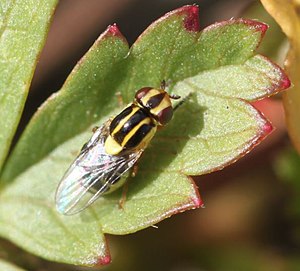Common straw fly
| Common straw fly | ||||||||||||
|---|---|---|---|---|---|---|---|---|---|---|---|---|

Common straw fly ( Thaumatomyia notata ) |
||||||||||||
| Systematics | ||||||||||||
|
||||||||||||
| Scientific name | ||||||||||||
| Thaumatomyia notata | ||||||||||||
| ( Meigen , 1830) |
The common stalk fly, or common grass stalk fly, ( Thaumatomyia notata ) is a two-winged fly from the family of stalk flies (Chloropidae).
features
The flies are 2-3 mm long. There are similar species both in the same genus and in the genus Chlorops, such as the yellow wheat stalk fly ( Chlorops pumilionis ). In contrast to the latter, the scutellum (shield) in Thaumatomyia is flat. The basic color of the flies is yellow. On the forehead there is usually a large, tapering, dark spot at the front, but this color is variable and can sometimes be missing. The first part of the antenna whip is almost spherical and black in color. The flies have a wide yellow border around the eyes. Three thick longitudinal bands run over the mesonotum and two more narrow ones at the side, so a total of five dark longitudinal bands. The scutellum is yellow. The holders are white. Broad, dark transverse ligaments run across the abdomen on the dorsal side. The legs are predominantly colored yellow.
The species can be distinguished from other representatives of the genus in our country, especially by the narrow genae (cheeks or cheeks). These are never more than half as wide as the length of the first segment of the antenna whip. Characteristic of the males are two yellow, evertable vesicles in the abdomen, which release a pheromone when mating.
distribution
The common stalk fly occurs in the Palearctic , in the Afrotropic and in the Oriental . It is widespread in Europe. To the north they occur up to about the 66th parallel , to the east to Japan. Thaumatomyia notata is represented in the entire Mediterranean area, in the Canary Islands and in the Azores .
Way of life
The flies can be seen from May to September. Occasionally the flies appear as early as February. There are always mass influx of Thaumatomyia notata . The flies feed on nectar and honeydew, they also take in the defense secretion of the larvae of the alder leaf beetle as food; they are often found on ivy blossoms or linden leaves covered with honeydew. The species forms at least 2 generations a year. The larvae predatory feed on aphids and root lice, especially pemphigus bursarius . The pupation takes place in the ground where a part of the type also wintered. In autumn, the flies look for winter quarters on buildings.
Mass appearances on buildings
The species is noticeable because of the occasional mass intrusions into buildings. On sunny days in late summer or early autumn, sometimes also in spring, cloud-like swarms of millions of the small flies appear, which target, mostly higher, buildings. They penetrate the inside of the building through the smallest of cracks and crevices, where they can be very annoying for the residents. The walls are soiled by the excrement, and after a while the panes of glass can look like frosted glass. The swarms appear over a long period of time, always in the same places. Many of the small flies die very soon, but most of them look for narrow cracks and cavities in which they hibernate. In addition to being a nuisance (classified as a nuisance ), flies can lead to economic and hygienic problems, especially in hospitals and public buildings that are open to the public. Such mass approaches have been described for many decades, but they seem to have become noticeably more frequent in recent years. The biological background of the aggregations and mass flights is still not understood today.
Taxonomy
The following synonyms can be found in the literature :
- Chlorops notata Meigen , 1830
Individual evidence
- ↑ a b c d Thaumatomyia notata / Common Halmfliege . www.naturspaziergang.de. Retrieved September 15, 2019.
- ↑ a b c d e Les CHLOROPIDES, petits à très petits diptères aux larves pouvant occasionner des dégâts importants aux Poacées (Graminées) ( fr ) aramel.free.fr. Retrieved September 15, 2019.
- ↑ a b c Emilia P. Nartshuk, Hugo Andersson: The Frit Flies (Chloropidae, Diptera) of Fennoscandia and Denmark. Fauna Entomologica Scandinavica, Volume 43. Brill, Leiden / Boston 2013. ISBN 978-90-04-16710-0 , on pages 226-228.
- ↑ a b c d Thaumatomyia notata in Fauna Europaea. Retrieved September 15, 2019
- ↑ a b c straw flies . Federal Environment Agency. Retrieved September 15, 2019.
- ↑ Thaumatomyia notata . www.biolib.cz. Retrieved September 15, 2019.
- ↑ Marion Kotrba and Emilia Nartshuk (2010): Mass occurrence of the common lawn stalk fly Thaumatomyia notata (Diptera, Chloropidae) on buildings: Determination - Biology - Distribution. Studia dipterologica 15: 193-209.
- ↑ Marion Kotrba (2010): Mass occurrence of the common grass stalk fly Thaumatomyia notata (Diptera, Chloropidae) on buildings - an increasing problem in our time? - Denisia 30: 451-456.
Web links
- Common grass stalk fly (Thaumatomyia notata) at www.schaedlingskunde.de
